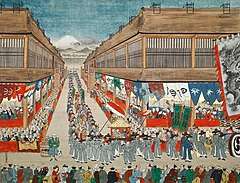Hong Gye-hui
Hong Gye-hui (1703–1771) was a scholar-official of the Joseon Dynasty Korea in the 18th century.
| Hong Gye-hui | |
| Hangul | 홍계희 |
|---|---|
| Hanja | 洪啓禧 |
| Revised Romanization | Hong Gye-hui |
| McCune–Reischauer | Hong Kye-hǔi |
He was also diplomat and ambassador, representing Joseon interests in the 10th Edo period diplomatic mission to the Tokugawa shogunate in Japan.[1]
1748 mission to Japan

In 1748, King Yeongjo of Joseon directed that a diplomatic mission to Japan would be dispatched.[1] This diplomatic mission functioned to the advantage of both the Japanese and the Koreans as a channel for developing a political foundation for trade.[2]
This delegation was explicitly identified by the Joseon court as a "Communication Envoy" (tongsinsa). The mission was understood to signify that relations were "normalized."[3]
This embassy traveled to Edo in the 1st year of the Japanese era of Kan'en, according to the Japanese calendar in use at that time.[4] The chief envoy of this Joseon delegation was Hong Gye-hui.[1]
Recognition in the West
Pak Tong-chi's historical significance was confirmed when his mission and his name were specifically mentioned in a widely distributed history published by the Oriental Translation Fund in 1834.[4]
In the West, early published accounts of the Joseon kingdom are not extensive, but they are found in Sangoku Tsūran Zusetsu (published in Paris in 1832),[5] and in Nihon ōdai ichiran (published in Paris in 1834). Joseon foreign relations and diplomacy are explicitly referenced in the 1834 work.
Popular culture
- Portrayed by Jang Hyun-sung in the 2014 SBS TV series Secret Door.
See also
- Joseon diplomacy
- Joseon missions to Japan
- Joseon tongsinsa
Notes
- Walraven, Boudewijn et al. (2007). Korea in the middle: Korean studies and area studies, p. 361.; Titsingh, Isaac. (1834). Annales des empereurs du japon, p. 418; n.b., the name Tcho ying is a pre-Hepburn Japanese transliteration and Tchao hing is a pre-McCune–Reischauer, Korean romanization devised by Julius Klaproth and Jean-Pierre Abel-Rémusat in 1834.
- Walker, Brett L. "Foreign Affairs and Frontiers in Early Modern Japan: A Historiographical Essay," Early Modern Japan. Fall, 2002, pp. 48.
- Lewis, James Bryant. (2003). Frontier contact between Chosŏn Korea and Tokugawa Japan, pp. 21-24.
- Titsingh, p. 418.
- Vos, Ken. "Accidental acquisitions: The nineteenth-century Korean collections in the National Museum of Ethnology, Part 1," Archived 2012-06-22 at the Wayback Machine p. 6.
References
- Daehwan, Noh. "The Eclectic Development of Neo-Confucianism and Statecraft from the 18th to the 19th Century," Korea Journal (Winter 2003).
- Lewis, James Bryant. (2003). Frontier contact between chosŏn Korea and Tokugawa Japan. London: Routledge. ISBN 978-0-7007-1301-1
- Titsingh, Isaac, ed. (1834). [Siyun-sai Rin-siyo/Hayashi Gahō, 1652], Nipon o daï itsi ran; ou, Annales des empereurs du Japon. Paris: Oriental Translation Fund of Great Britain and Ireland. OCLC 84067437
- Walker, Brett L. "Foreign Affairs and Frontiers in Early Modern Japan: A Historiographical Essay," Early Modern Japan. Fall, 2002, pp. 44–62, 124-128.
- Walraven, Boudewijn and Remco E. Breuker. (2007). Korea in the middle: Korean studies and area studies; Essays in Honour of Boudewijn Walraven. Leiden: CNWS Publications. ISBN 90-5789-153-0; OCLC 181625480
External links
- Joseon Tongsinsa Cultural Exchange Association (in Korean); (in Japanese)
- 조선통신사연구 (Journal of Studies in Joseon Tongsinsa) (in Korean)
| Preceded by Hong Chi-jung |
Joseon–Japanese Edo period diplomacy 10th mission 1748 |
Succeeded by Jo Eom |